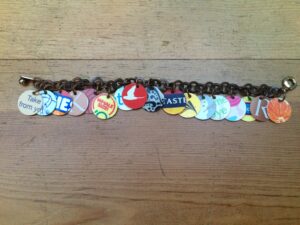People have been making leather from fish skin for centuries. Others have used fish scales to decorate boxes and make jewelry. Learn how artists have creatively reused these materials historically and to make art today.
You can listen to this podcast episode on how people creatively reuse fish parts in this YouTube video. It originally aired in December 2020:
The photo at the top of this blog is a gyotaku or fish print made by William Twibell in 1987. It is a rosebud rockfish. This was a gift from my colleague when I worked at the American Oceans Campaign in 1999. Learn more about gyotaku artist Naoki Hayashi in this video by Great Big Story:
Fish Scales
In this episode I talk about how I am an assistant Scoutmaster and have been working with Scouts on their Fish and Wildlife Management merit badge. One of the requirements for that badge is to calculate the age of a fish from its scale. Fish scales have rings on them like tree rings that get denser in the winter.

How to Calculate a Fish’s Age from Its Scale
Fish Scale Jewelry
Sailor’s Valentines – Boxes decorated with sea shells and fish scales
Reel AK Jewelry – earrings by an Alaska fishermen and artist
Fish Skin
Fish skin as food – In Hong Kong, fried fish skin with salted egg yolk is sold as a packaged snack. In China, there is a fish skin salad. In Taiwan and Japan, you can eat pickled fish skin.
Fish skin as leather
Janey Chan teaches classes on making fish skin leather
The Smithsonian hosted workshops on fish skin leather
Seven Leagues is designing boots from fish skin leather
Junk Kouture – At this trash fashion show, the winner of the prize for Most Unusual Material in 2018 was Fear Leighis na Mara Plaisteach or Plastic Marine Man, which included a vest made from fish skins.
Vivian Ross-Smith makes tapestries from fish skin.
Fish Bones
Cynthia Gibson made a dress decorated from 20,000 salmon vertebrae bones.
High Tech Fish Waste Upcycling
In 2019, Lucy Hughes won the James Dyson award, which is a design award program for students. She invented a biodegradable plastic called MarineTex made from fish scales and skin. It can compost in a home composter in six weeks. It doesn’t require an industrial composter.
The Power Knot liquid food composter can digest fish waste in 24 hours. It’s a great way to reduce trash from fish processing plants or restaurants. Learn more in Zero Waste Countdown, episode 90, May 2020.
Crocheted Seafood
Kate Jenkins crochets all kinds of food. I love her seafood and how she gives them shiny fish scales made from sequins. In 2015, she crocheted an entire fish counter with every kind of seafood, all glittering with tiny sequin fish scales.



